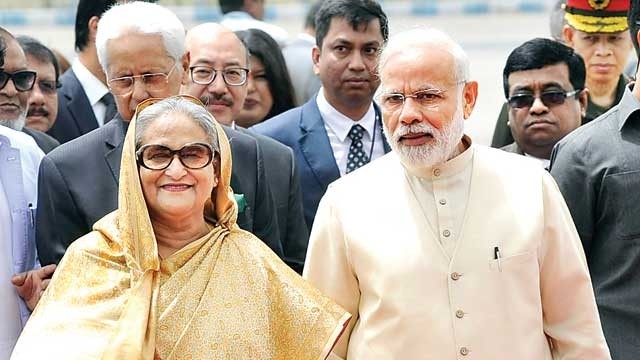
India has not only lost its tag as the fastest growing economy, it is even lagging behind its former 'poor cousin’ Bangladesh, which grew by 8.1 per cent last financial year as against India’s 6.8 per cent. Similarly, while India’s growth forecast for the current fiscal has been slashed to just 6.1 per cent, Bangladesh is forecast to grow at a spanking 8.3 per cent pace.
The neighbouring nation, whose Prime Minister is visiting Delhi looking for support in a number of fields, is quite right in boasting of its success story – its per capita income has risen from a lowly $543 in 2006 to $2,000 in 2019. Its exports have similarly tripled in the last 12 years to $40.53 bilion and its foreign currency reserve has boomed to $33 billion. Hard facts that have seen Asian Development Bank (ADB) rating it as the fastest growing nation in the Asia-Pacific.
Bangladesh’s Prime Minister Sheikh Hasina reminded an audience of Indian captains of industry on Friday that her country “is the second-largest garment exporter, fourth largest rice producer and the eighth largest remittance earning country.”
What changed the terms over the last few years from when India was the toast for global business and Bangladesh was an also ran? In the last three years, India went in for a massive demonetisation exercise, which stifled its informal sector and slashed growth and soon after followed this up by introducing a new, hastily designed Goods and Services Tax which did not help grow the economy either. After recovering somewhat from these twin deleterious economic events, India was hit again by the aftershocks of a slowing global economy and shrinking of demand from over-cautious retail consumers.
India’s GDP growth chart during the period looks like a series of hills and dales as economy starts slowing down after November 2016 demonetisation and then starts recovering as the effects of the GST introduction are addressed and then again starts slowing down after April 2018.
In contrast, Bangladesh concentrated on spending massively to improve its physical and social infrastructure which helped create jobs and a healthier and better educated workforce. According to 'Trading Economics', Bangladesh’s current unemployment rate is 4.3 per cent. India’s, according to CMIE, stood at 8.4 per cent in August 2019. “We have concentrated on infrastructure building which has led to a boom in jobs and demand. Once that construction of roads, bridges, ports, SEZs is over we will have to find other ways – but right now that is what is driving our economy,” said top Bangladeshi official, part of Sheikh Hasina's entourage.
India’s economists have been calling for a loosening of fiscal deficit and an investment push in infrastructure which could help create new jobs and new demand to ramp up the country’s slowing growth. However, till now the government has concentrated on tax relief for the corporate sector and sectoral policy changes hoping it would help tide over the current economic hump.
The sustained investment in social capital by the state and non-governmental sector has similarly seen Bangladeshis’ average life expectancy rise to a current 72 years, compared to 68 years for Indians, and its literacy rate going up to 73.9 per cent compared to India’s 69.1 per cent.
The other major difference was Bangladesh concentrated on creating more manufacturing jobs instead of service sector growth. Despite having a narrower basket of industries, dominated by garments, Bangladesh managed to speed up its exports growth rate from 6.7 per cent in 2018 to 10.1 per cent in 2019. “Bangladesh managed to get its priorities right. Concentrate on job creation – through infrastructure and manufacturing, thus boosting domestic consumption and give the right incentives and facilities to exporters including export of human capital to earn vital foreign exchange assets. We have forgotten lessons which they seem to have learnt from us,” said Prof. Biswajit Dhar of the JNU.


.jpeg)

